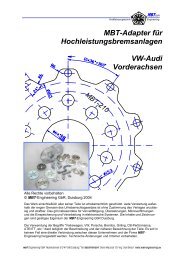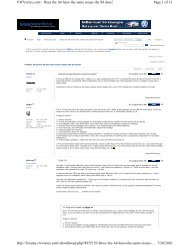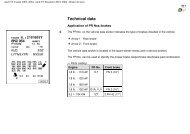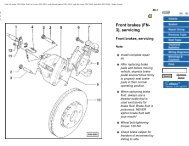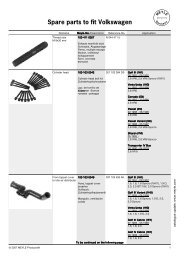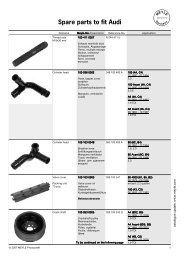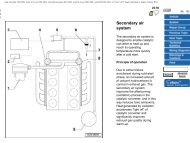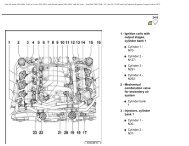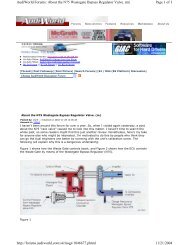VW MKII A2 MK2 Golf Jetta Fox Service Manual - VAGLinks.com
VW MKII A2 MK2 Golf Jetta Fox Service Manual - VAGLinks.com
VW MKII A2 MK2 Golf Jetta Fox Service Manual - VAGLinks.com
Create successful ePaper yourself
Turn your PDF publications into a flip-book with our unique Google optimized e-Paper software.
4F•2 Fuel and exhaust systems - Digifant fuel injection<br />
2.6 Crankcase ventilation pressure regulating valve (1) and<br />
temperature sender (2)<br />
2 Idle speed and mixture (CO<br />
content) - adjustment 4<br />
1 Run the engine until the oil temperature is<br />
at least 80°C. This should correspond to<br />
normal operating temperature.<br />
2 Switch off all electrical <strong>com</strong>ponents,<br />
including the air conditioning, where fitted.<br />
Note that the radiator fan must be stationary<br />
during adjustment.<br />
3 For accurate adjustment, the throttle valve<br />
switch and idling stabilisation control valve<br />
must be functioning correctly and the ignition<br />
timing must be correct.<br />
4 With the engine stopped, connect a<br />
tachometer to the engine. Plug one of the<br />
exhaust tailpipes and position the probe of an<br />
exhaust gas analyser in the remaining pipe.<br />
5 Disconnect the crankcase ventilation hose<br />
from the pressure regulating valve on the<br />
valve cover and plug the hose.<br />
6 Run the engine at idle speed. After<br />
approximately one minute, disconnect the<br />
wire from the temperature sender (see<br />
illustration) and quickly increase the engine<br />
speed to 3000 rpm three times.<br />
7 With the engine idling, check the idle speed<br />
and CO content. If necessary, adjust the<br />
screws (see illustration). The CO adjustment<br />
screw is fitted with a tamperproof plug at the<br />
factory. This plug should be prised out before<br />
making an adjustment.<br />
8 Reconnect the temperature sender wire<br />
and again quickly increase the engine speed<br />
to 3000 rpm three times. With the engine<br />
idling, the idle speed and CO content should<br />
be as specified. If necessary, make any small<br />
corrections required.<br />
9 Fit a new tamperproof plug.<br />
10 Reconnect the crankcase ventilation<br />
hose. Note that if this increases the CO<br />
content, do not alter the adjustment. The<br />
cause is fuel dilution of the engine oil due to<br />
frequent stop/start use. A long fast drive<br />
should reduce the CO content to the correct<br />
level. Alternatively, an oil change will achieve<br />
the same objective.<br />
3 Idle speed stabilisation<br />
system - testing 2<br />
1 Check that the stabilisation control valve<br />
buzzes when the ignition is switched on. If<br />
not, use an ohmmeter to check the continuity<br />
valve after pulling off the connector (see<br />
illustration).<br />
2 Run the engine until the oil temperature is<br />
at least 80°C. This should correspond to<br />
normal operating temperature.<br />
3 Connect a multi-meter to the stabilisation<br />
control valve in series with the existing wiring.<br />
4 All electrical <strong>com</strong>ponents must be switched<br />
off during the test and power steering (where<br />
fitted) centralised.<br />
5 Run the engine at idle speed. After<br />
approximately one minute, quickly increase<br />
the engine speed to 3000 rpm three times. At<br />
idling speed, the control current should be<br />
approximately 420 ± 30 mA and fluctuating.<br />
With the temperature sender plug<br />
disconnected, the current should be<br />
approximately 420 ± 30 mA but constant.<br />
3.1 Idle speed stabilisation control valve<br />
(1)<br />
1081 <strong>VW</strong> <strong>Golf</strong> & <strong>Jetta</strong><br />
2.7 Idle speed adjusting screw (1) and mixture (CO content)<br />
adjusting screw (2)<br />
4 Automatic air cleaner<br />
temperature control - testing 2<br />
1 Disconnect the hose from the vacuum unit<br />
then remove the air cleaner cover and<br />
element.<br />
2 Check that the flap in the lower body is<br />
closing the warm air inlet.<br />
3 Suck on the vacuum hose and check that<br />
the flap moves freely to close the cold air inlet.<br />
4 Flap operation may be checked with the<br />
engine idling by extending the vacuum hose<br />
and positioning a thermometer by the<br />
temperature regulator. Below 20°C, the cold<br />
air inlet must be closed. Above 30°C, the<br />
warm air inlet must be closed. Between 20°C<br />
and 30°C, the flap should be positioned<br />
midway so that both inlets are open.<br />
5 Refit the air cleaner element and cover,<br />
then reconnect the hose.<br />
5 Throttle valve switches -<br />
testing and adjustment 2<br />
1 There are two throttle valve switches.<br />
Switch 1 monitors the throttle valve closed<br />
position and switch 2 monitors the throttle<br />
valve fully open position (see illustration).<br />
2 Disconnect the supply plug from switch 2<br />
and check that approximately 5 volts is<br />
available across the two terminals with the<br />
ignition switched on. If not, check the wiring<br />
from the control unit.<br />
3 Connect an ohmmeter across the terminals<br />
of switch 2, then slowly open the throttle valve<br />
until the switch points close. The gap at the<br />
throttle lever stop must be 0.20 to 0.60 mm<br />
when the points close. If necessary, adjust the<br />
position of switch 1.<br />
4 A piece of card marked with 10° is required<br />
to check switch 2. Attach the card to the first<br />
stage throttle valve shaft.



